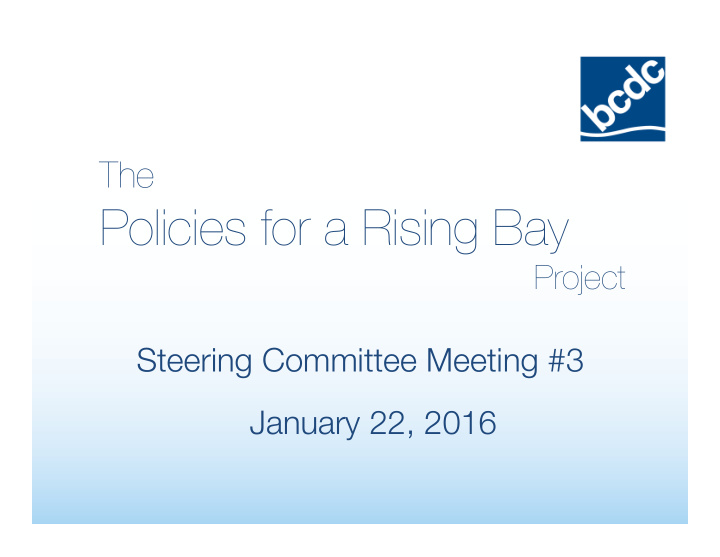



The Policies for a Rising Bay Project Steering Committee Meeting #3 January 22, 2016
Overview • Brief Presentation of Case Studies – Developed in collaboration with subcommittee – Case studies are hypothetical • Brief Presentation of Policy Analysis – Incorporates feedback from subcommittee meetings – Highlights key policy issues • Discussion
The Policies for a Rising Bay Project Transportation Case Study Miriam Torres Erik Buehmann
• Purpose: maintain ground transportation, shoreline habitat and recreation resources, and protect the surrounding community from future flooding Gr Ground T ound Transportation ransportation
Lid + Mudflat Recharge & Beach • Seawall and Lid: – 30 feet high wall with a park and public access – Bay trail is relocated to the top of the lid – Protection: 100-year BFE + 5.5 feet of SLR • Mudflat Recharge & Beach: – Initial placement: 98 acres of sediment over 13,000 linear feet – Sediment tapering linearly for about 400 feet into the Bay – Wave attenuation, recreational, and habitat benefits
Current Conditions & SLR
Mudflat Recharge, Beach, Lid Bay Fill = 98 acres over 13,000 linear feet / 647,443 cubic yards (cy) Shoreline Band Fill = 21 acres / 315,519 cy of sediment / 31,551 cy of groins
Impacts Seawall: • Erosion of o ff shore mudflats • Potential shoreline erosion • Bay views • Public access Mudflat Recharge + Beach: • Habitat loss and gain • Siltation
Case Study Analysis • Minimum Fill • Benefits and Detriments • Mitigation
Policy Issues • Minimum fill issues – Long-term impacts of beach recharge – Potential habitat benefits and impacts – Alternatives that could provide benefits with less fill
Policy Issues • Public Benefits and Public Detriments – Flood protection • Highway • Community – Increased public access – Habitat loss – Loss of open water area Photo: SF Chronicle
Policy Issues • Mitigation – Substantial amount of fill = substantial mitigation – Fee-based mitigation unlikely – Supplemental mitigation for beach replenishment
Discussion
Questions • How to encourage innovative sea level rise approaches and minimize the potential of failure? • How to weigh long-term potential public benefits over short-term impacts? • How should mitigation be evaluated for sea level rise adaptation projects?
The Policies for a Rising Bay Project Shoreline Community Case Study Miriam Torres Brenda Goeden
• Purpose: flood protection along the creek and Bay front, prepare marsh for a rising Bay. Shor Shoreline Community eline Community
Tide Gate Tide Gate: – Concrete structure with gated culverts – Top of the gate at 11ft. NAVD88 – Protection: 3 feet of SLR above MHHW (with 2 ft. of freeboard)
Horizontal Levee & � Sediment Augmentation Proposal: • Flood protection • Build levee to 16’ NAVD88 with a 30:1 slope • Protection: 3 feet of SLR • Provide transition habitat • Reuse finer grained dredged sediment from creek to raise grades of the marsh
Horizontal Levee Bay Fill = 69 acres over 10,000 linear feet / 555,555 cubic yards
Potential Impacts Tide Gate: • Hydrology • Habitat & Wildlife • Sediment transport Horizontal Levee: • Habitat • Wildlife • Public access
Applicable BCDC Laws & Policies McAteer Petris Act Sections 66601, 66605, and 66632* • Relevant San Francisco Bay Plan Policies* • Fish, Other Aquatic Organisms and Wildlife (1, 2, & 4) • Water Quality (1, & 2) • Water Surface Area and Volume (1, 2 & 3) • Tidal Marsh and Tidal Flats (1, 2, 3, 5, 6 & 8) • Climate Change (1, 2, 3, 5 & 7) • Safety of Fill (1, 2, & 4) • Shoreline Protection (1, 3, 4, & 5) • Dredging (2, 3, 4, & 11) • Public Access (1, 2, 5) • Appearance, Design and Scenic Views (2) • Fill in Accord with the Bay Plan (1) • Mitigation (All) •
Tide Gate • Protects existing development from flooding • Policies that protect species, habitat and physical processes and impacts • Near term flood protection benefits vs. long-term strategy • Mitigation
Horizontal Levee • Protects community and provides transitional habitat • Impacts to healthy marsh and policies • Expected time lag in habitat development • Mitigation may be required
Sediment Augmentation • Beneficial reuse of sediment • Temporal loss of habitat within creek • Marsh plain elevation capital • Potentially self-mitigating
Other Considerations • Policy consistency depends on details of the project • More information is necessary • Short-term vs. long-term impacts and benefits • Public detriments and benefits apply to the region
Discussion
Questions • How to evaluate tide gate impacts to long-term land use decisions and natural processes? • How to weigh long-term potential public benefits over short-term impacts? • How should mitigation be evaluated for sea level rise adaptation projects?
Recommend
More recommend